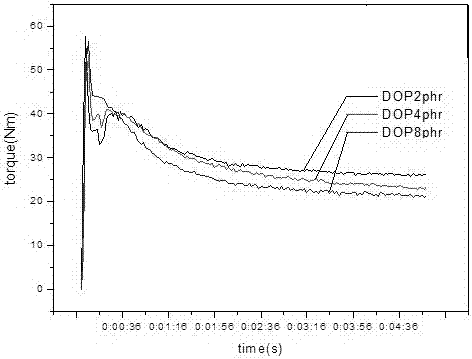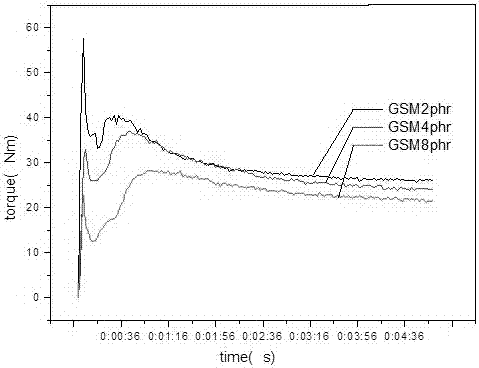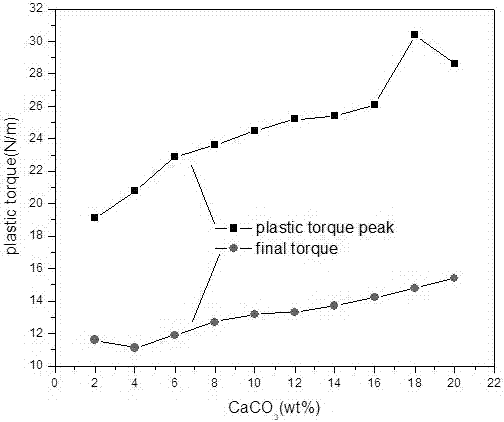High-heat-resistance PVC/ABS alloy material modified by nanometer calcium carbonate filling material and preparation method thereof
A technology of nano-calcium carbonate and alloy materials, which is applied in the field of high heat-resistant PVC/ABS alloy materials and their preparation, and can solve problems such as mechanical performance degradation, PVC fluidity deterioration, and unfeasible products.
- Summary
- Abstract
- Description
- Claims
- Application Information
AI Technical Summary
Problems solved by technology
Method used
Image
Examples
Embodiment 1
[0034] (1) The raw materials are configured according to the following mass parts: 78 parts of PVC, 10 parts of ABS; 6 parts of nano-calcium carbonate; 0.2 parts of pentaerythritol diphosphite; 1 part of calcium-zinc composite stabilizer; 1 part of methoxysilane; 2 parts of dioctyl dicarboxylate; 2 parts of glyceryl monostearate.
[0035] (2) Drying the mass parts of PVC at 80°C for 1 hour;
[0036] (3) Drying the mass parts of ABS at 80°C for 3 hours;
[0037] (4) Mechanically stir and mix the dried PVC / ABS with the aforementioned mass parts of nano-calcium carbonate, heat stabilizer, antioxidant, internal lubricant, and plasticizer for 20 minutes at a stirring rate of 5000 rpm;
[0038] (5) Add the mixture in step (4) and the silane coupling agent in parts by mass to a torque rheometer for molding. The processing technology of the torque rheometer is as follows: the torque rheometer The heating zone is divided into three zones, and the temperature of the three heating zone...
Embodiment 2
[0045] (1) The raw materials are configured according to the following mass parts: 60 parts of PVC, 7 parts of ABS; 20 parts of nano-calcium carbonate; 0.3 parts of 2,8-di-tert-butyl-4-methylphenol; 2 parts of lead salt composite stabilizer; 1 part of epoxy silane; 5 parts of dioctyl phthalate; 5 parts of glyceryl monostearate.
[0046](2) Drying the mass parts of PVC at 75°C for 2 hours;
[0047] (3) Drying the mass parts of ABS at 80°C for 3 hours;
[0048] (4) Mechanically stir and mix the dried PVC / ABS with the aforementioned mass parts of nano-calcium carbonate, heat stabilizer, antioxidant, internal lubricant, and plasticizer for 30 minutes at a stirring rate of 5000 rpm;
[0049] (5) Add the mixture in step (4) and the silane coupling agent in parts by mass to a torque rheometer for molding. The processing technology of the torque rheometer is as follows: the torque rheometer The heating zone is divided into three zones, and the temperature of the three heating zones ...
Embodiment 3
[0056] (1) The raw materials are configured according to the following mass parts: 28 parts of PVC, 5 parts of ABS; 48 parts of nano-calcium carbonate; 0.3 parts of 2,8-di-tert-butyl-4-methylphenol; 1 part of OBS organic base stabilizer; Aminosilane, 2 parts; Dicapryl phthalate 8 parts; Glyceryl monostearate 8 parts.
[0057] (2) Drying the mass parts of PVC at 85°C for 2 hours;
[0058] (3) Drying the mass parts of ABS at 75°C for 4 hours;
[0059] (4) Mechanically stir and mix the dried PVC / ABS with the above mass parts of nano-calcium carbonate, heat stabilizer, antioxidant, internal lubricant, and plasticizer for 25 minutes at a stirring rate of 3000 rpm;
[0060] (5) Add the mixture in step (4) and the silane coupling agent in parts by mass to a torque rheometer for molding. The processing technology of the torque rheometer is as follows: the torque rheometer The heating zone is divided into three zones, and the temperature of the three heating zones is controlled at 18...
PUM
| Property | Measurement | Unit |
|---|---|---|
| Notched impact strength | aaaaa | aaaaa |
| Tensile strength | aaaaa | aaaaa |
| Vicat softening point | aaaaa | aaaaa |
Abstract
Description
Claims
Application Information
 Login to View More
Login to View More - R&D
- Intellectual Property
- Life Sciences
- Materials
- Tech Scout
- Unparalleled Data Quality
- Higher Quality Content
- 60% Fewer Hallucinations
Browse by: Latest US Patents, China's latest patents, Technical Efficacy Thesaurus, Application Domain, Technology Topic, Popular Technical Reports.
© 2025 PatSnap. All rights reserved.Legal|Privacy policy|Modern Slavery Act Transparency Statement|Sitemap|About US| Contact US: help@patsnap.com



